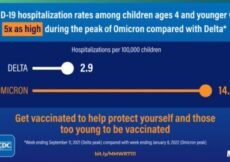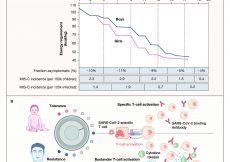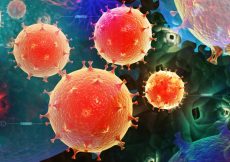March 2nd, 2022
Scrolling though Facebook recently, I came across a post from the American Academy of Pediatrics, which said: “While most cancers can’t be prevented, cancers caused by HPV can be!”
Every parent with a teenager knows that cervical cancer in women and oropharyngeal cancers in both women and men associated with HPV infection can easily be prevented with 2 doses of the vaccine. But to say that most cancers can’t be prevented is simply incorrect. In fact, the World Health Organization estimates that at least 30-50% of all cancer cases are preventable by avoiding or modifying key risk factors and lifestyle behaviors.
Reducing the risk of getting cancer is very much in our own hands. A study published in 2008 revealed that only 5-10% of human cancers originated as a result of hereditary (genetic) defects, whereas environmental and lifestyle factors account for 90-95% of cancers. The researchers attributed cancer-related deaths to the usual suspects:
• Tobacco (including smokeless): 25-30% of cancer-related deaths (87% of deaths from lung cancer)
• Diet (red meat, food additives in processed foods, alcohol) and obesity: 30-35%
• Infections: 15-20%
• Radiation exposure (including UV light and radon gas), stress, physical inactivity, and environmental pollution were noted to be important lifestyle and environmental risk factors.
Recently I was asked to join a panel of public health experts at the Dana-Farber Cancer Institute in Boston, MA to discuss the connection between air pollution and cancer. The virtual program — Cancer & Environment Forum 2022: What Does New Science Say About Chemicals & Cancer? Lessons From Public Health & Environmental Medicine — was aimed at health care providers, policymakers, cancer researchers, and the general public. As a pediatrician living and working in the Pittsburgh region, I attempted to provide a health professional’s perspective of the area’s long-standing problems with air pollution and high cancer rates — problems that haven’t resolved as much as some would like us to believe. Here are my prepared comments for the panel which was held on February 16, 2022.
I’d like to thank the Dana Farber Cancer Institute for producing this session and inviting me to speak to all of you gathered here virtually today. As Polly just mentioned, I live and work just south of the city of Pittsburgh, in Washington County, PA, which just so happens to be the most heavily fracked county in the state. Southwestern PA is a lovely place to live and work, or just visit. I love it here, loved starting a family and raising my children here, and decided a few years back that it’s a place worth staying and fighting for.
If you’ve never been here, I’m sure you’ve heard the stories of when pollution from steel mills and coal-fired power plants darkened noonday skies. “Hell with the lid off” is how some described this industrial city of coal, iron, and steel. The city’s three rivers were not a feature but a bug in the landscape, a convenient sewer for vast amounts of industrial waste.
This was an area of the country where people emigrated from distant lands for the promise of dangerous but steady jobs — jobs that also promised to shorten your life and threaten the health of your family and friends, even as it put food on the table.
In this way, pollution was, and still is, normalized — it’s just the cost of progress. And the cancer people are still developing at rates higher than the national average has also been normalized. “Poor Charlie has cancer. How unlucky is he?” Well, no. It’s very likely Charlie’s cancer had nothing to do with luck, and everything to do with the fine particle pollution and toxic gases that escape from local industry into the atmosphere like an open sewer.
A lot of the steel industry has now left the region, though US Steel still operates steel mills and coke facilities that still make the air stinky and my neighbors sick.
While the air looks cleaner than it did back in the day, we know that looks can be deceiving. What is better than before is still not good enough for pediatricians like me who wish so many kids didn’t suffer the negative health consequences of so much “progress.”
It was mentioned earlier that even reductions in smoking, which has been a huge public health success story across the nation over the last couple of decades, doesn’t have quite the impact in reducing cancer risk for residents living here compared to other cities and counties with better air quality.
In some Pittsburgh neighborhoods, children have asthma rates nearly three times higher than the rest of the state and country.
Pittsburgh lies in the center of Allegheny County, which ranks among the worst 1% of counties nationwide for cancer risks from industrial point sources of air pollution.
In 7 surrounding southwestern PA counties, incidence rates of 6 types of cancer strongly linked to toxic chemical exposures (bladder, breast, kidney, lung, leukemia, and thyroid) are elevated, some by more than 50% compared with national rates. I myself am lucky enough to have survived kidney cancer a few years back, but I don’t think it was bad luck that I developed it in the first place.
Those of us living in southwestern Pennsylvania are exposed to greater levels of pollution than most other places in the US, and that has disproportionate impacts on minority and vulnerable communities.
The truth is, children might be the most vulnerable of all. Some counties in southwestern PA have striking elevations of cancer incidence. The Pennsylvania Department of Health is currently investigating high rates of rare childhood cancers, including Ewing sarcoma, in a four-county region with high fracking activity.
And there are new point sources of heavy industrial pollution coming down the pike that will impact the health of residents here. Shell is nearly done building a massive ethane cracker plant in nearby Beaver County. One of the largest petrochemical factories ever built anywhere, the Shell plant will take fracked gas and transform it into tiny polyethylene pellets in order to make single-use plastic — one thing Mother Nature doesn’t need anymore of. We know what happens to cancer rates and overall health in people who live near petrochemical plants like this one, and many of us are afraid our home in the upper Ohio River Valley will shortly become America’s next Cancer Alley, just like Louisiana and Texas is now, and New Jersey, where I was born and raised.
What should health professionals do to help their patients?
— Know your zip code! Understand where your area’s environmental health threats are coming from. Know what neighborhoods your patients are coming from.
— Check local air quality forecasts at airnow.gov every morning before leaving for the office or hospital. This morning, once again, the closest air monitor to me is measuring the worst air quality in the nation for PM2.5. That knowledge will help me take better care of my patients today.
— Advocate for your patients, and teach them how to advocate for themselves.
— Be courageous and speak up. Don’t be afraid to talk with patients about air pollution, environmental health, and climate change.
— Don’t be satisfied with “better than it was before” — it’s still not good enough! Putting a filter on a cigarette might make it a little cleaner, but no doctor is going to tell you to go ahead and smoke it.
You can watch a recording of the Cancer & Environment Forum 2022 for yourself here.
Read more about cancer prevention on The PediaBlog here.
When he isn’t writing and editing The PediaBlog, Dr. Ketyer is president of Physicians for Social Responsibility Pennsylvania. He is a member of the American Academy of Pediatrics Council on Environmental Health and Climate Change, medical advisor for Environmental Health Project, and actively participates in the Cancer & Environment Network of Southwestern Pennsylvania.




































